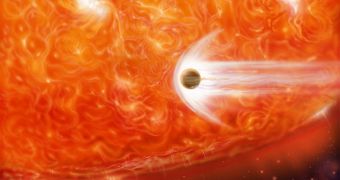Yesterday, November 18, astronomers announced the existence of an exoplanet that was “born” in another galaxy, and then was engulfed by the Milky Way. Experts now say that studying this system may yield some insight into Earth's ultimate fate in our own solar system.
Deeper studies of the exoplanet and its parent star could also help astronomers make more sense of how our solar system will look like once the Sun reaches the end of its burning cycle, turns into a red giant, and then finally into a white dwarf.
The exoplanet, called HIP 13044b, is a gas giant with a mass 25 percent larger than that of Jupiter. It orbits its parent star at a distance of just 5 million miles, which means that the length of a year there is just a little over 16 Earth days.
The star originated in a nearby dwarf galaxy some 6 to 9 billion years ago, and entered the Milky Way when our galaxy merged with the smaller one. Since HIP 13044 was born, it has already passed through many changes, Space reports.
For example, the star turned into a red giant many years ago, which means that its atmosphere expanded considerably, most likely engulfing the exoplanet entirely. Yet, that did not destroy the body, which is something astronomers did not though was possible.
What is more interesting however is that both HIP 13044 and the Sun are similar stars, which means that they developed in roughly the same way. The distant star is however farther along the evolutionary line.
This is why astronomers hope to use it to figure out how the Sun will behave in the next 3 to 6 billion years. It is estimated that our star will reach the red giant phase in about 5 billion years, after it exhausts its hydrogen supplies.
One of the things that astronomers find interesting about this star system is the fact that the orbit of the exoplanet was most likely a lot more distant from the star than it is today. Astronomers hypothesize that the red giant phase is what derailed the planet from its previous orbit, bringing it so close to HIP 13044.
The initial distance is probably what allowed the exoplanet to endure, experts believe. Had it been close to the star from the get-go, it probably wouldn't have survived the red giant phase.
In our own solar system, only Mars and gas giants will most likely escape the bloating of the Sun. The rest of the inner planets – Earth, Venus and Mercury – will be destroyed and engulfed by the Sun.
The remaining planets would then rearrange their orbits, and places such as the Saturnine moons Titan and Enceladus may look pretty much the way Earth looks today. They may become our new home a couple of billion years from now.

 14 DAY TRIAL //
14 DAY TRIAL //